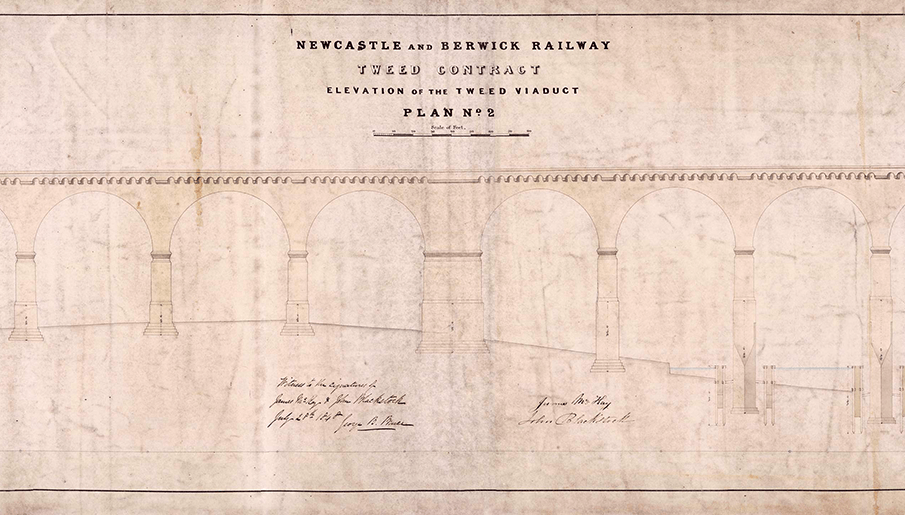The history of the Royal Border Bridge, Berwick
The Royal Border Bridge was the last link in completing a continuous railway line running between London and Edinburgh.
Designed by Robert Stephenson, the bridge was a more traditional masonry structure than its contemporaries the High Level and Britannia bridges. But it is one that has stood the test of time.

The last link
By July 1847 the lines from Edinburgh to Berwick (North British Railway) had opened. So had the lines from Tweedmouth to Newcastle (Newcastle & Berwick Railway). The journey between stations was undertaken by a horse drawn coach. These were at Berwick on one side of the Tweed and Tweedmouth on the other. On 15 May 1847 the Newcastle and Berwick Railway laid the foundation stone for a bridge crossing the Tweed. This would link Tweedmouth with Berwick.
The bridge, known initially at the ‘Tweed Viaduct’, was designed by Robert Stephenson, assisted by Thomas E Harrison. Contractors McKay & Blackstock were appointed. And George Barclay Bruce was chosen to be the Newcastle & Berwick’s resident engineer, overseeing the day to day work. He was a Newcastle-born former apprentice of Robert Stephenson.
Design and construction
The bridge designed by Stephenson was a conventional masonry structure. It had 28 semicircular arches, each spanning 61½ft (19 meters) in a gentle curve. Thirteen arches spanned the river, and 15 were over land to the south at Tweedmouth. The bridge had a central abutment pier. This allowed the 15 land arches to be completed before starting on the river arches. The pier foundations had to penetrate almost 40 feet (12 meters) of dense gravel to reach bedrock. The bridge used 8 million cubic feet (227,000 cubic meters) of stone. With 2½ million bricks set in cement and faced with stone for the inner part of the arches. The bridge is 2,160ft (656 meters) long and 126ft (38 meters) high above the river. With rails at 120ft (37 meters). At its peak, 2,700 men worked on the construction.
As work on the Royal Border Bridge began, Robert Stephenson and Thomas Harrison were also working on the High Level Bridge in Newcastle. Many techniques used there were applied to the Tweed crossing. To keep the railway moving, a temporary wooden bridge was built alongside the permanent structure and opened to rail traffic in September 1848. The foundation piles for the Royal Border Bridge were driven to bedrock using Nasmyth’s new steam-powered pile driver.
Opening and lifetime
Although the permanent bridge was scheduled for completion in July 1849, it wasn’t ready until March 1850. Queen Victoria and Prince Albert opened the bridge on August 29, 1850, and she allowed it to be named the Royal Border Bridge.
In 1989, electrification gantries were installed on the bridge as part of the electrification of the line between London and Edinburgh. These gantries were specially designed to reduce visual impact and were approved by the Royal Fine Art Commission. After 143 years as part of the East Coast Mainline, the bridge underwent significant maintenance for the first time in 1993. This project, in partnership with English Heritage, repaired the 15 land-based arches. In 2010, to celebrate its 160th anniversary, the bridge was illuminated.
Did you know?
The Royal Border Bridge is actually located entirely in England. The East Coast Main Line crosses the English – Scottish border at Marshall Meadows, which is 2.5 miles north of Berwick.